A Non-Manipulated Variable Analysis of Solid-Phase Combustion in the Furnace of Municipal Solid-Waste Incineration Process Based on the Biorthogonal Numerical-Simulation Experiment
Abstract
:1. Introduction
2. Solid-Phase Combustion Analysis of the MSWI Process for Non-Manipulated Variables
2.1. Description of Solid Phase Combustion in the Furnace
2.2. Non-Manipulated Variable Analysis of Influencing the MSWI Process
3. Materials and Methods
3.1. Materials
3.2. Methods
3.2.1. Numerical Model Construction of the Benchmark Operating Condition
Solid Phase Combustion Model in the Furnace
Basic Conservation Equation
Equations of Species Transport and Heat Radiation Transfers
3.2.2. Numerical Simulation Experiment of Biorthogonal Multi-Operating Conditions
3.2.3. Single Factor Analysis of Non-Manipulated Variables
4. Simulation Results and Discussion
4.1. Simulation Results and Discussion of the Benchmark Operating Condition
4.2. Simulation Results and Discussion of Biorthogonal Multi-Conditions
4.3. Results and Discussion of Non-Manipulated Variables in Single-Factor Analysis
4.3.1. MSW Particle Size
4.3.2. Particle Mixing Coefficient
4.3.3. Emissivity
4.3.4. Moisture content
4.3.5. C:O Ratio
4.4. Comprehensive Analysis
5. Conclusions
Author Contributions
Funding
Institutional Review Board Statement
Informed Consent Statement
Data Availability Statement
Conflicts of Interest
References
- Tang, J.; Xia, H.; Yu, W.; Qian, J.F. Research status and prospects of intelligent optimization control for municipal solid waste incineration process. Acta Autom. Sin. 2023; accept. [Google Scholar] [CrossRef]
- Pham, T.P.T.; Kaushik, R.; Parshetti, G.K.; Mahmood, R.; Balasubramanian, R. Food waste-to-energy conversion technologies: Current status and future directions. Waste Manag. 2015, 38, 399–408. [Google Scholar] [CrossRef] [PubMed]
- Alao, M.A.; Popoola, O.M.; Ayodele, T.R. Waste-to-energy nexus: An overview of technologies and implementation for sustainable development. Clean. Energy Syst. 2022, 3, 100034. [Google Scholar] [CrossRef]
- Shin, D.; Choi, S. The combustion of simulated waste particles in a fixed bed. Combust. Flame 2000, 121, 167–180. [Google Scholar] [CrossRef]
- Goh, Y.R.; Yang, Y.B.; Zakaria, R.; Siddall, R.G.; Nasserzadeh, V.; Swithenbank, J. Development of an Incinerator Bed Model for Municipal Solid Waste Incineration. Combust. Sci. Technol. 2001, 162, 37–58. [Google Scholar] [CrossRef]
- Yang, Y.B.; Goh, Y.R.; Zakaria, R.; Nasserzadeh, V.; Swithenbank, J. Mathematical modelling of MSW incineration on a travelling bed. Waste Manag. 2002, 22, 369–380. [Google Scholar] [CrossRef] [PubMed]
- Yang, Y.B.; Newman, R.; Sharifi, V.; Swithenbank, J.; Aris, J. Mathematical modelling of straw combustion in a 38 MWe power plant furnace and effect of operating conditions. Fuel 2007, 86, 129–142. [Google Scholar] [CrossRef]
- Yu, Z.; Ma, X.; Liao, Y. Mathematical modeling of combustion in a grate-fired boiler burning straw and effect of operating conditions under air- and oxygen-enriched atmospheres. Renew. Energy 2010, 35, 895–903. [Google Scholar] [CrossRef]
- Ryu, C.; Yang, Y.B.; Nasserzadeh, V.; Swithenbank, J. Thermal reaction modeling of a large municipal solid waste incinerator. Combust. Sci. Technol. 2004, 176, 1891–1907. [Google Scholar] [CrossRef]
- Goddard, C.D.; Yang, Y.B.; Goodfellow, J.; Sharifi, V.N.; Swithenbank, J.; Chartier, J.; Mouquet, D.; Kirkman, R.; Barlow, D.; Moseley, S. Optimisation study of a large waste-to-energy plant using computational modelling and experimental measurements. J. Energy Inst. 2005, 78, 106–116. [Google Scholar] [CrossRef]
- Ismail, T.M.; Abd EL-Salam, M.; El-Kady, M.A.; El-Haggar, S.M. Three dimensional model of transport and chemical late phenomena on a MSW incinerator. Int. J. Therm. Sci. 2014, 77, 139–157. [Google Scholar] [CrossRef]
- Yang, Y.B.; Lim, C.N.; Goodfellow, J.; Sharifi, V.N.; Swithenbank, J. A diffusion model for particle mixing in a packed bed of burning solids. Fuel 2005, 84, 213–225. [Google Scholar] [CrossRef]
- Yang, Y.B.; Ryu, C.; Khor, A.; Sharifi, V.N.; Swithenbank, J. Fuel size effect on pinewood combustion in a packed bed. Fuel 2005, 84, 2026–2038. [Google Scholar] [CrossRef]
- Yang, Y.B.; Yamauchi, H.; Nasserzadeh, V.; Swithenbank, J. Effects of fuel devolatilisation on the combustion of wood chips and incineration of simulated municipal solid wastes in a packed bed. Fuel 2003, 82, 2205–2221. [Google Scholar] [CrossRef]
- Yang, Y.B.; Sharifi, V.N.; Swithenbank, J. Effect of air flow rate and fuel moisture on the burning behaviours of biomass and simulated municipal solid wastes in packed beds. Fuel 2004, 83, 1553–1562. [Google Scholar] [CrossRef]
- Yan, M.; Tian, X.; Antoni; Yu, C.; Zhou, Z.; Hantoko, D.; Kanchanatip, E.; Khan, M.S. Influence of multi-temperature primary air on the characteristics of MSW combustion in a moving grate incinerator. J. Environ. Chem. Eng. 2021, 9, 106690. [Google Scholar] [CrossRef]
- Yan, M.; Antoni; Wang, J.; Hantoko, D.; Kanchanatip, E. Numerical investigation of MSW combustion influenced by air preheating in a full-scale moving grate incinerator. Fuel 2021, 285, 119193. [Google Scholar] [CrossRef]
- Aliman, I.; Pasek, A.D. The evaluation of experimental and numerical study of combustion process on mini traveling chain grate furnace (incinerator) by computational fluid dynamics method. In Proceedings of the International Conference on Thermal Science & Technology, Helsinki, Finland, 19–20 July 2018. [Google Scholar]
- Liang, Z.; Ma, X. Mathematical modeling of MSW combustion and SNCR in a full-scale municipal incinerator and effects of grate speed and oxygen-enriched atmospheres on operating conditions. Waste Manag. 2010, 30, 2520–2529. [Google Scholar] [CrossRef]
- Hu, Z.; Jiang, E.; Ma, X. Numerical simulation on NOx emissions in a municipal solid waste incinerator. J. Clean. Prod. 2019, 233, 650–664. [Google Scholar] [CrossRef]
- Lin, T.; Liao, Y.; Dai, T.; Ma, X. Investigation on co-disposal technology of sludge and municipal solid waste based on numerical simulation. Fuel 2023, 343, 127882. [Google Scholar] [CrossRef]
- Chen, J.; Tang, J.; Xia, H.; Yu, W.; Qiao, J. Modelling the furnace temperature field of a municipal solid waste incinerator using the numerical simulation and the deep forest regression algorithm. Fuel 2023, 347, 128511. [Google Scholar] [CrossRef]
- Gu, T.; Yin, C.; Ma, W.; Chen, G. Municipal solid waste incineration in a packed bed: A comprehensive modeling study with experimental validation. Appl. Energy 2019, 247, 127–139. [Google Scholar] [CrossRef]
- Sun, R.; Ismail, T.M.; Ren, X.; El-Salam, M.A. Influence of simulated MSW sizes on the combustion process in a fixed bed: CFD and experimental approaches. Waste Manag. 2016, 49, 272–286. [Google Scholar] [CrossRef] [PubMed]
- Yang, Y.B.; Swithenbank, J. Mathematical modelling of particle mixing effect on the combustion of municipal solid wastes in a packed-bed furnace. Waste Manag 2008, 28, 1290–1300. [Google Scholar] [CrossRef] [PubMed]
- Sun, R.; Ismail, T.M.; Ren, X.; El-Salam, M.A. Numerical and experimental studies on effects of moisture content on combustion characteristics of simulated municipal solid wastes in a fixed bed. Waste Manag. 2015, 39, 166–178. [Google Scholar] [CrossRef] [PubMed]
- Meng, H.; Li, Y.-F.; Zhang, C. Modeling of discharge voltage for lithium-ion batteries through orthogonal experiments at subzero environment. J. Energy Storage 2022, 52, 105058. [Google Scholar] [CrossRef]
- Zhuang, J.; Tang, J.; Aljerf, L. Comprehensive review on mechanism analysis and numerical simulation of municipal solid waste incineration process based on mechanical grate. Fuel 2022, 320, 123826. [Google Scholar] [CrossRef]
- Yang, Y.B.; Sharifi, V.N.; Swithenbank, J. Converting moving-grate incineration from combustion to gasification—Numerical simulation of the burning characteristics. Waste Manag. 2007, 27, 645–655. [Google Scholar] [CrossRef]
- Yang, Y.B.; Sharifi, V.N.; Swithenbank, J. Numerical simulation of Municipal Solid Waste incineration in a moving-grate furnace and the effect of waste moisture content. Prog. Comput. Fluid Dyn. Int. J. 2007, 7, 261–273. [Google Scholar] [CrossRef]
- Arthur, J.R. Reactions between carbon and oxygen. Trans. Faraday Soc. 1951, 47, 164–178. [Google Scholar] [CrossRef]
- Yang, Y.B.; Goodfellow, J.; Sharifi, V.N.; Swithenbank, J. Investigation of biomass combustion systems using CFD techniques: A parametric study of packed-bed burning characteristics. Prog. Comput. Fluid Dyn. 2006, 6, 262–271. [Google Scholar] [CrossRef]
- Fernando, N.; Narayana, M. A comprehensive two dimensional Computational Fluid Dynamics model for an updraft biomass gasifier. Renew. Energy 2016, 99, 698–710. [Google Scholar] [CrossRef]
- Smoot, L.D.; Pratt, D.T. Pulverized-Coal Combustion and Gasification; Springer: Berlin/Heidelberg, Germany, 1979. [Google Scholar]
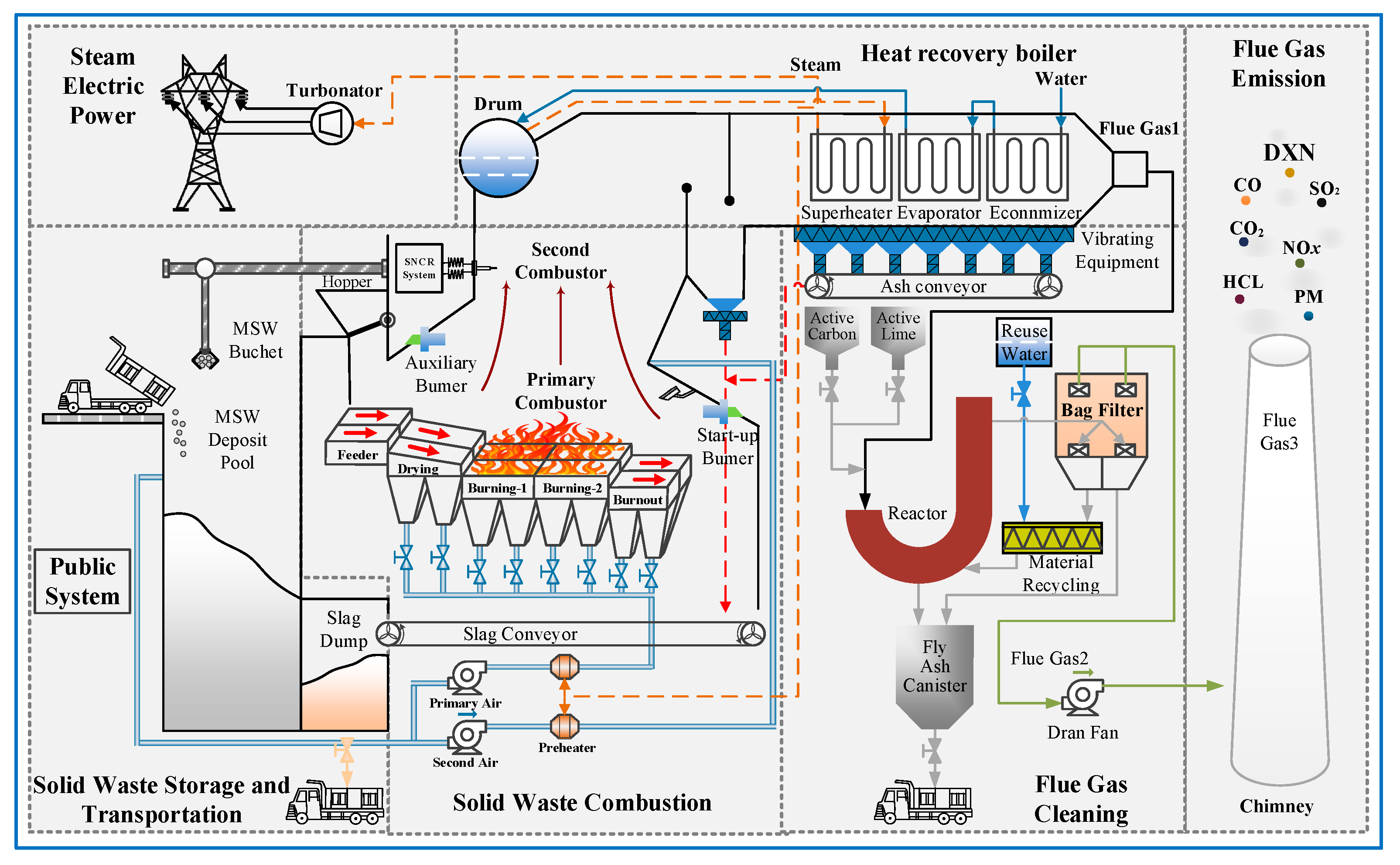

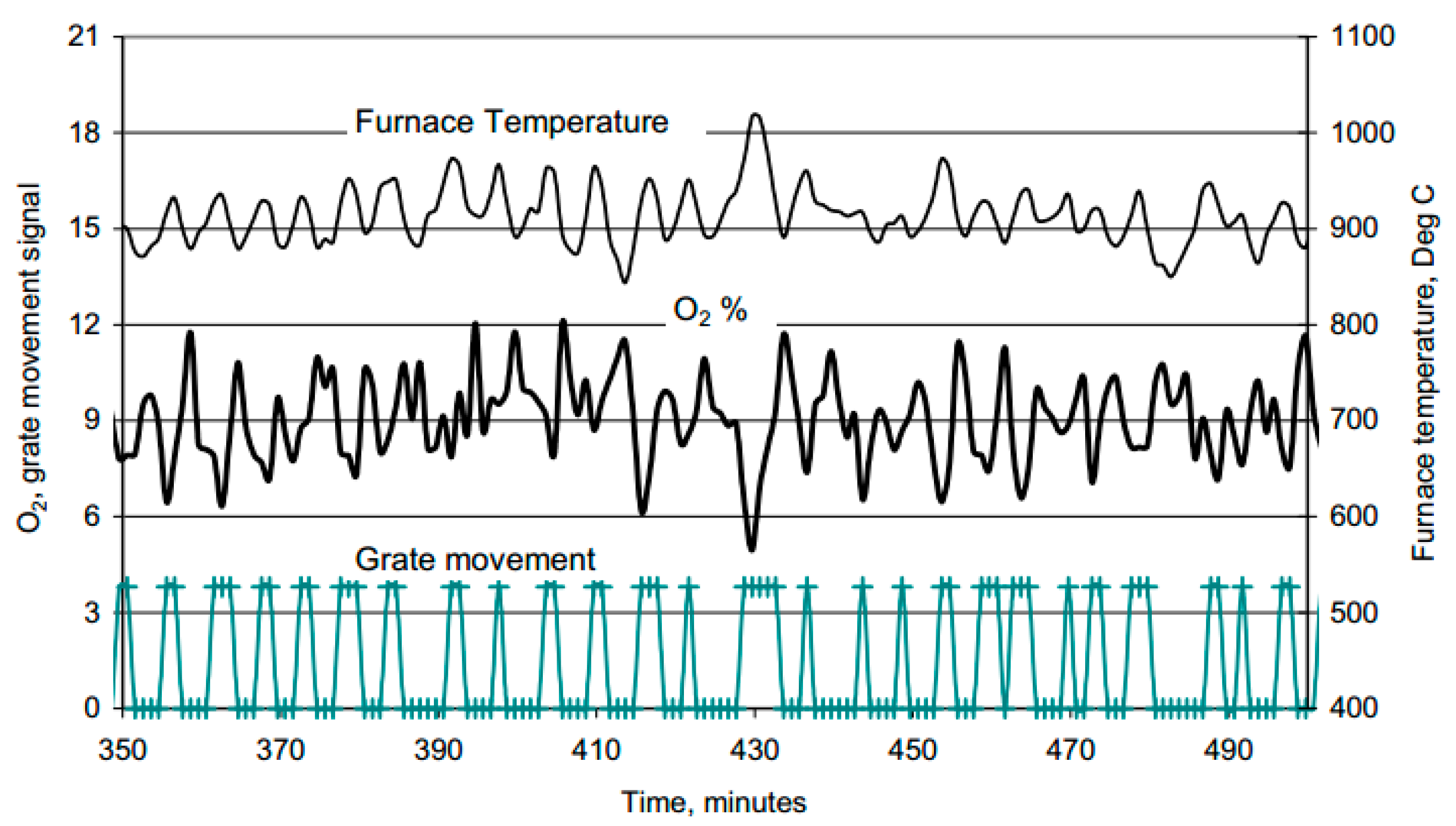
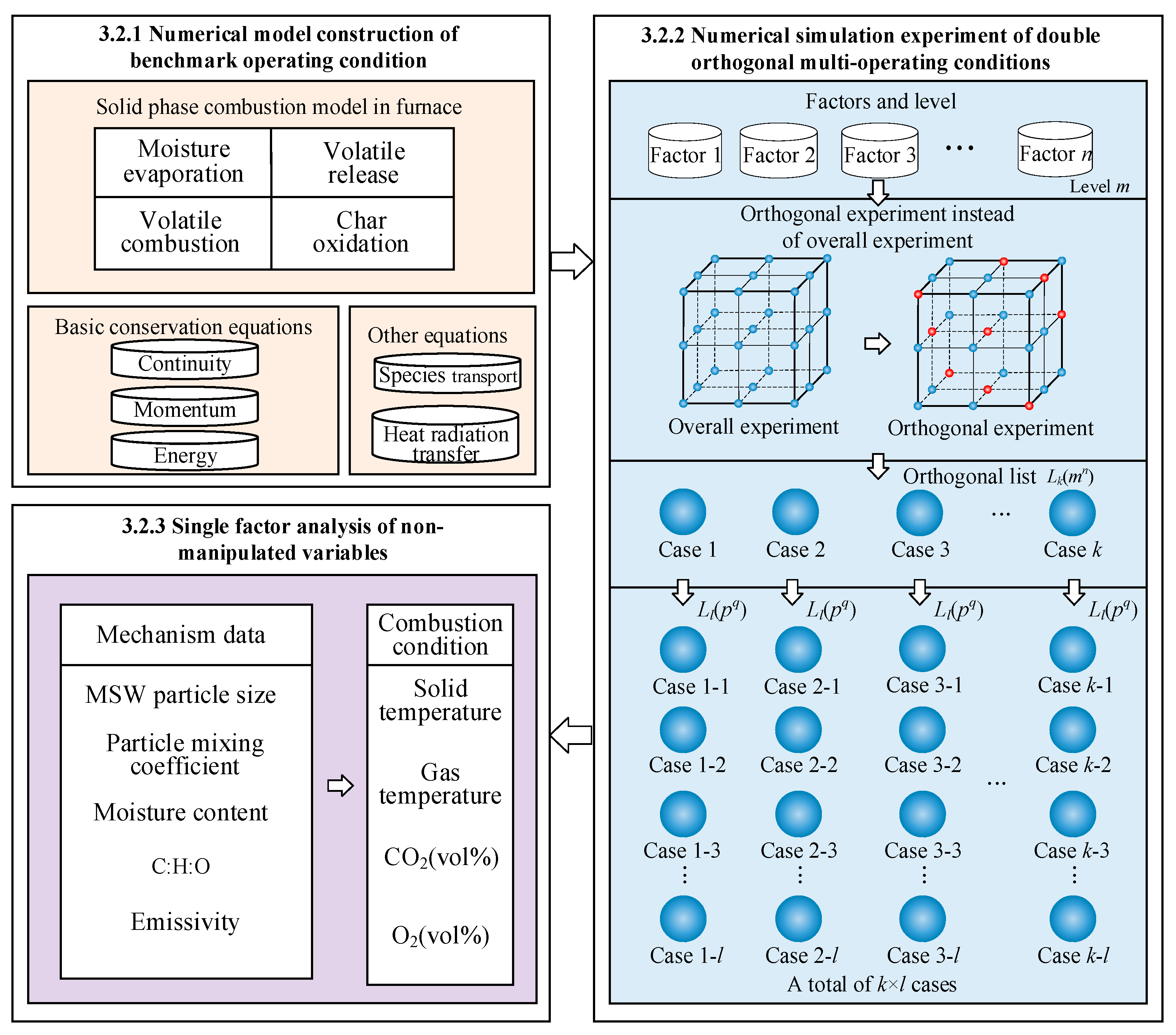
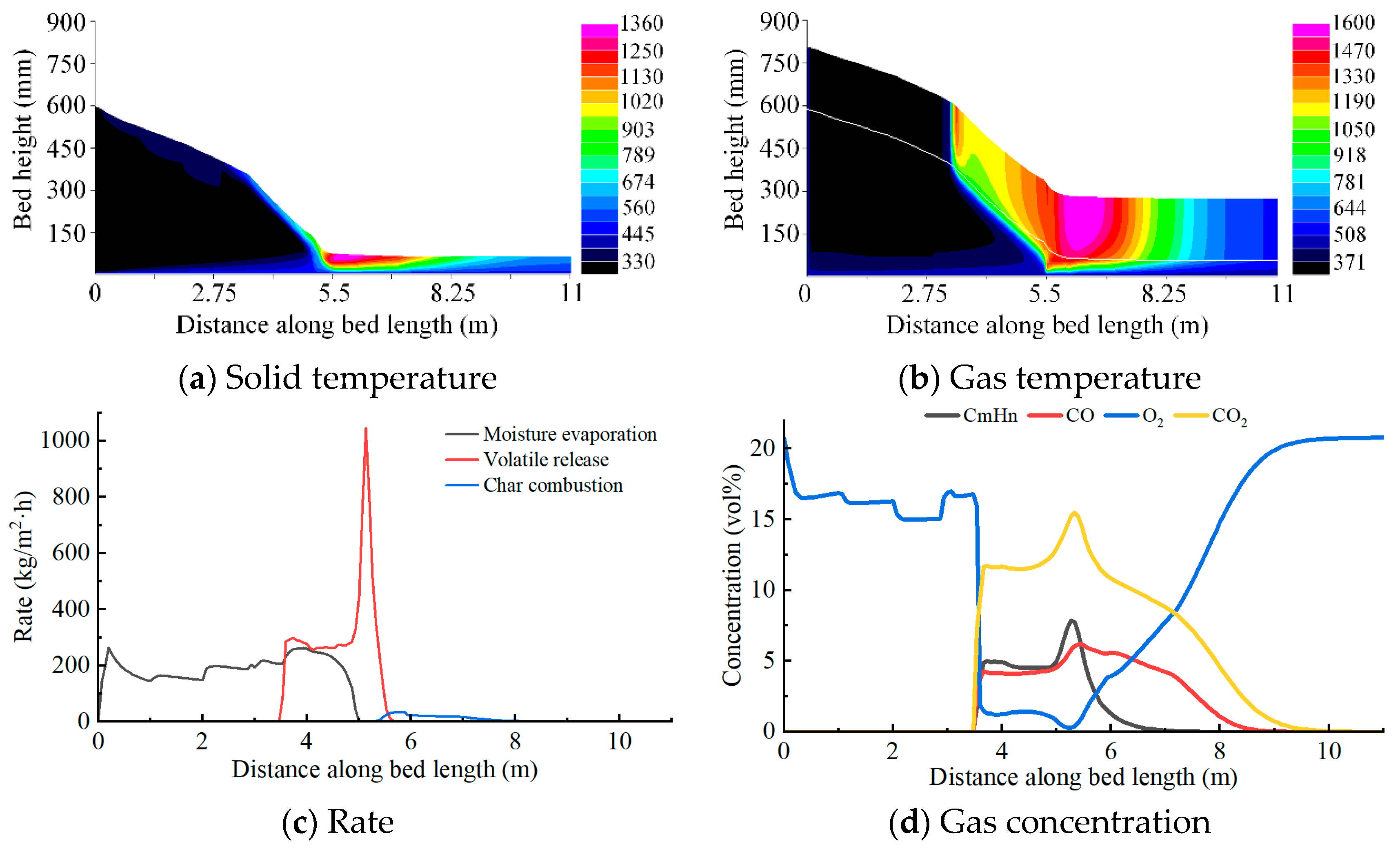

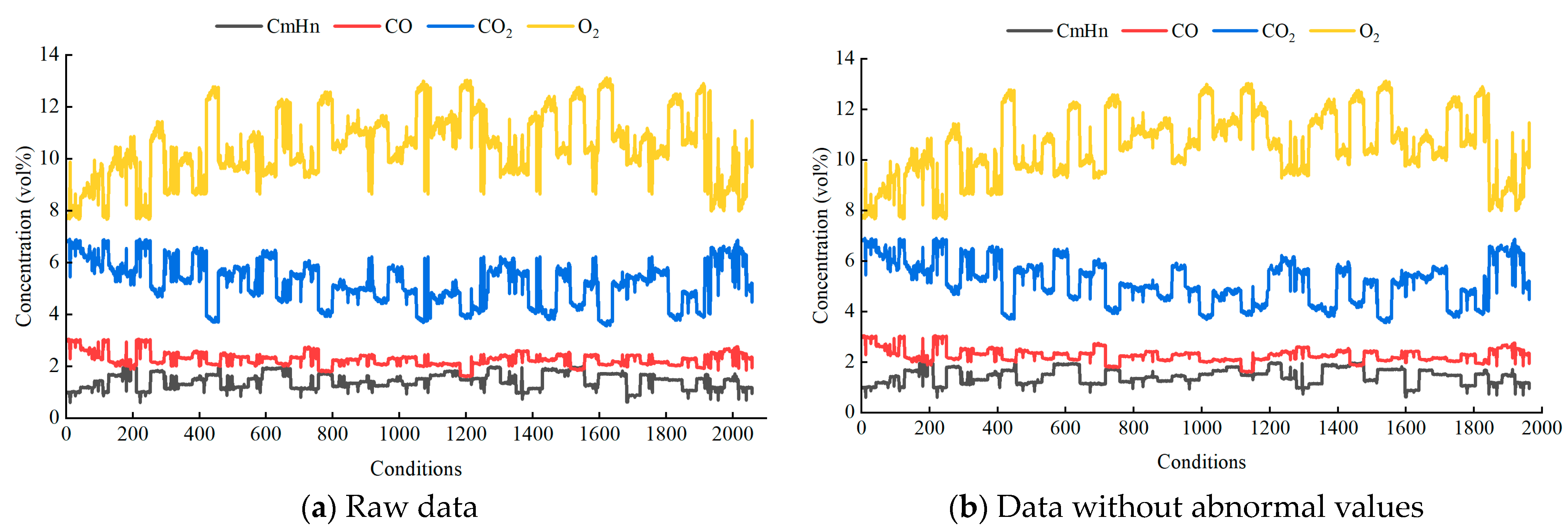





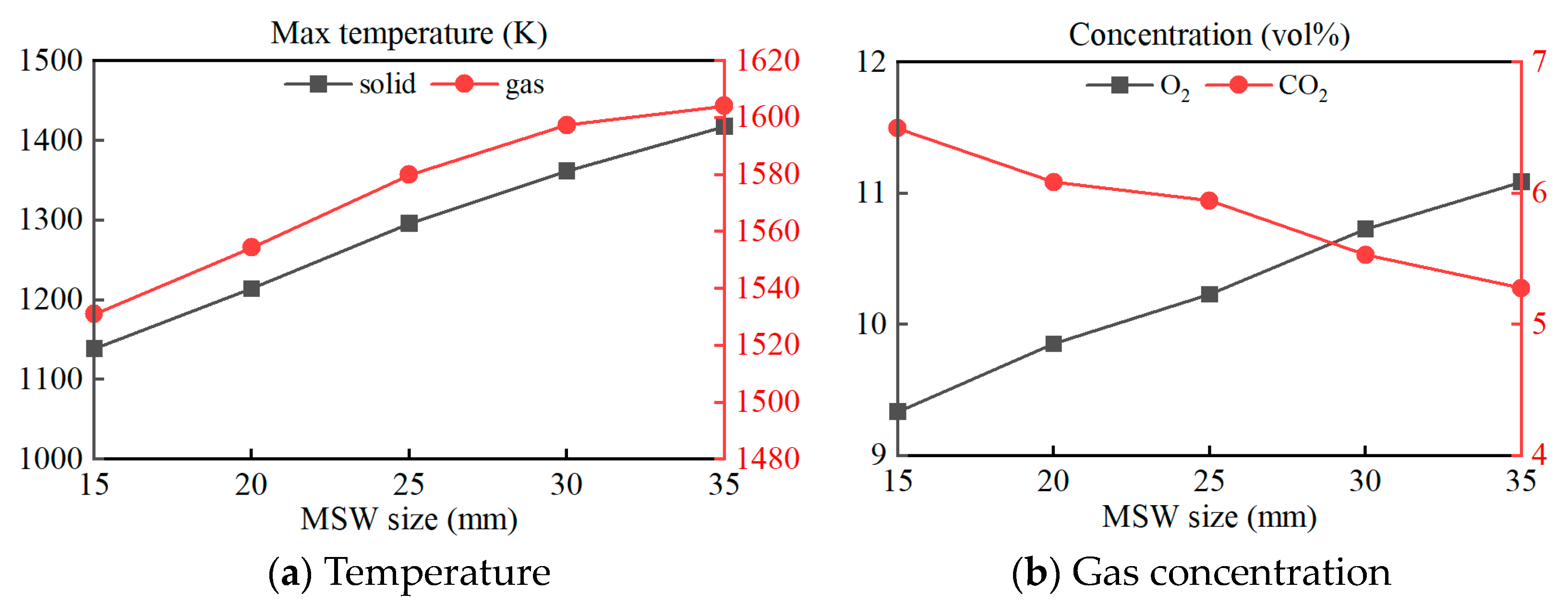

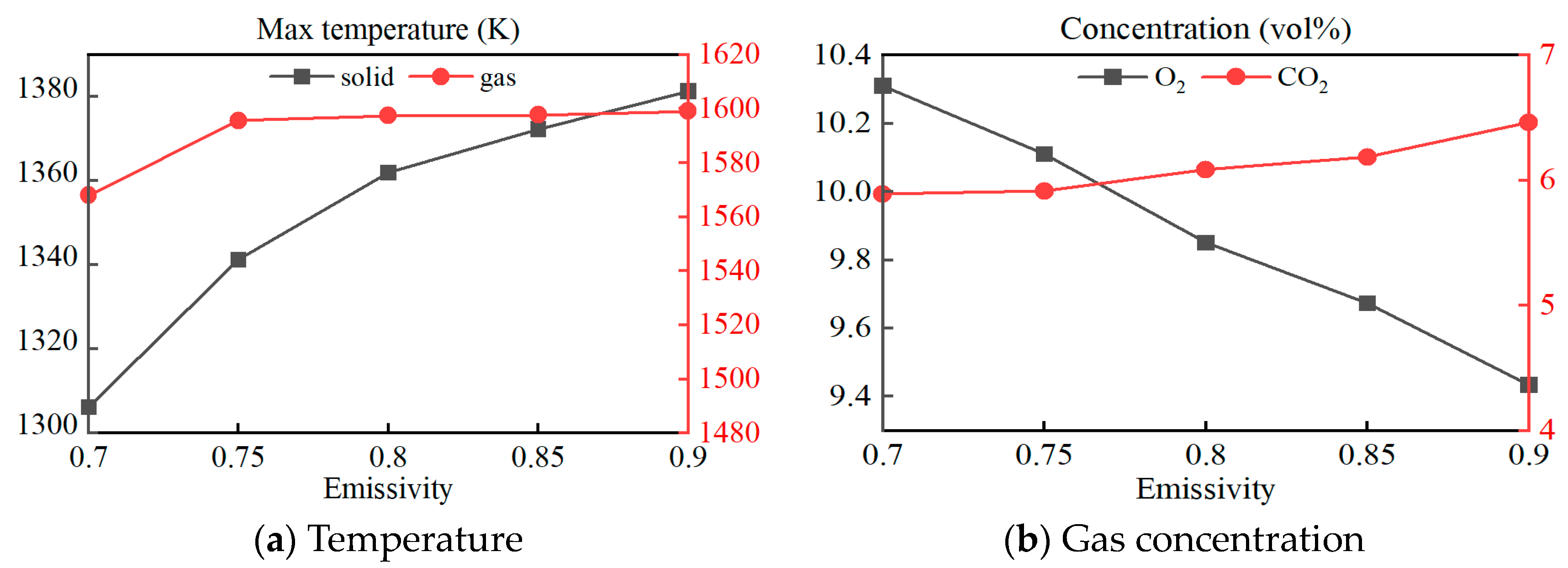
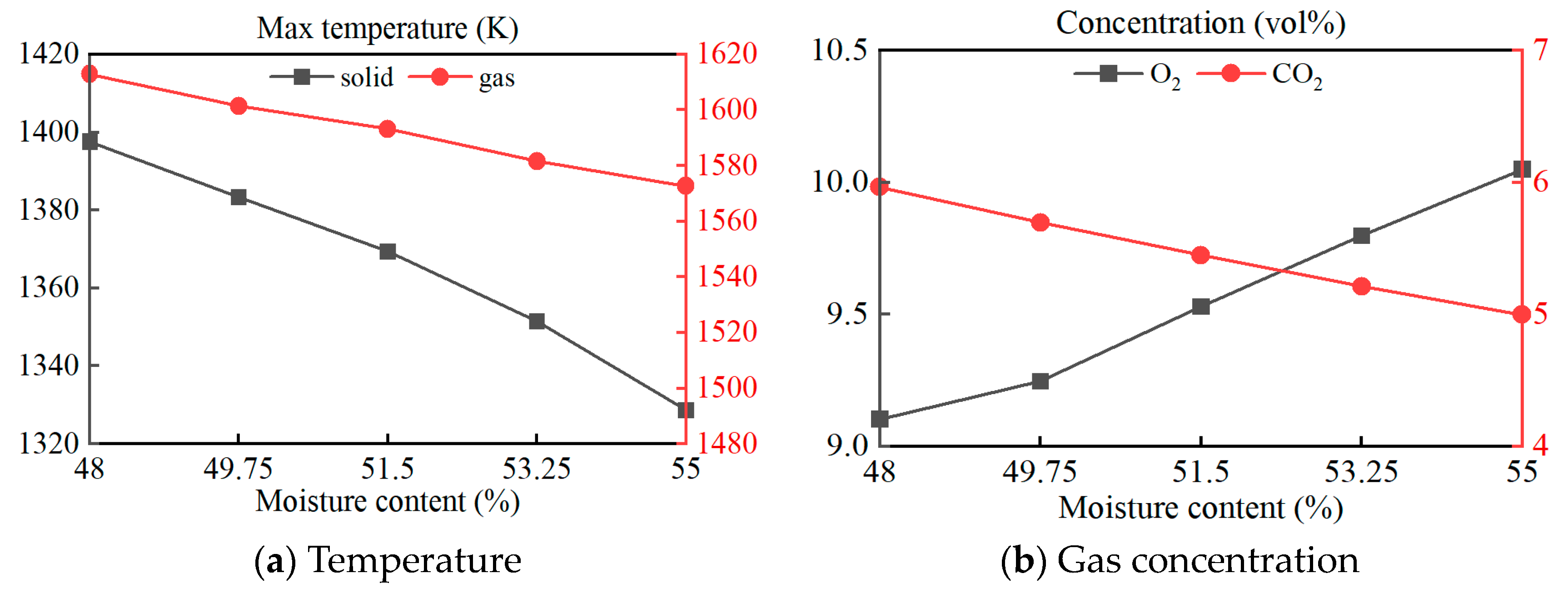

| Proximate (as a Received Basis, wt%) | Ultimate (as a Dry Ash-Free Basis, wt%) | ||
|---|---|---|---|
| Moisture | 48 | C | 65.2 |
| Volatile matter | 33.31 | H | 8.09 |
| Fixed carbon; | 8.08 | O | 24.93 |
| Ash | 10.61 | N | 1.12 |
| S | 0.24 | ||
| Parameter | Value |
|---|---|
| Capacity, t/d | 628.8 |
| Type of grate | Reciprocating grate |
| Grate length × width, m | 11 × 12.9 |
| Grate speed, m/h | 8 |
| Primary airflow, Nm3/h | 67,500 |
| Air temperature, °C | 200 |
| Air distribution, % | 24.31, 43.35, 19.27, and 13.07 |
| Factor | Level Value | |
|---|---|---|
| Manipulated variables | Feeding, m/h | 7, 7.5, 8, 8.5, and 9 |
| Grate speed, t/h | 24.2, 24.7, 25.2, 25.7, and 26.2 | |
| Primary air in drying, Nm3/min | 268, 274, 280, 286, and 292 | |
| Primary air in burning 1, Nm3/min | 477, 488, 499, 510, and 521 | |
| Primary air in burning 2, Nm3/min | 211, 216, 221, 226, and 231 | |
| Primary air in burnout, Nm3/min | 144, 147, 150, 153, and 156 | |
| Non-manipulated variables | Particle size, mm | 15, 20, 25, 30, and 35 |
| Particle mixing coefficient | 2 × 10−6, 3 × 10−6, 4 × 10−6, 5 × 10−6, and 6 × 10−6 | |
| Moisture content, % | 48, 49.75, 51.5, 53.25, and 55 | |
| C:O | (58:33), (59:32), (60:31), (61:30), and (62:29) |
| Factor | Level Value | Factor | Level Value |
|---|---|---|---|
| Grate speed, m/h | 6.6, 6.7, 6.8, 6.9, and 7 | Feeding, t/h | 24.2, 24.3, 24.4, 24.5, and 24.6 |
| 7.1, 7.2, 7.3, 7.4, and 7.5 | 24.7, 27.8, 24.9, 25, and 25.1 | ||
| 7.6, 7.7,7.8, 7.9, and 8 | 25.2, 25.3, 25.4, 25.5, and 25.6 | ||
| 8.1, 8.2, 8.3, 8.4, and 8.5 | 25.7, 25.8, 25.9, 26, and 26.1 | ||
| 8.6, 8.7, 8.8, 8.9, and 9 | 26.2, 26.3, 26.4, 26.5, and 26.6 | ||
| Primary air in drying, Nm3/min | 255, 256.8, 258.6, 260.4, and 262.2 | Primary air in burning 1, Nm3/min | 455, 458.2, 461.4, 464.6, and 467.8 |
| 264, 265.8, 267.6, 269.4, and 271.2 | 471, 474.2, 477.4, 480.6, and 483.8 | ||
| 273, 274.8, 276.6, 278.4, and 280.2 | 487, 490.2, 493.4, 496.6, and 499.8 | ||
| 282, 283.8, 285.6, 287.4, and 289.2 | 503, 506.2, 509, 513, and 515.8 | ||
| 291, 292.8, 294.6, 296.4, and 298.2 | 519, 522.2, 525.4, 528.6, and 531.8 | ||
| Primary air in burning 2, Nm3/min | 203, 204.4, 205.8, 207.2, and 208.6 | Primary air in burnout, Nm3/min | 137, 138, 139, 140, and 141 |
| 210, 211.4, 212.8, 214.2, and 215.6 | 142, 143,144, 145, and 146 | ||
| 217, 218.4, 219.8, 221.2, and 222.6 | 147, 148, 149, 150, and 151 | ||
| 224, 225.4, 227, 228, and 229.6 | 152, 153, 154, 155, and 156 | ||
| 231, 232.4, 233.8, 235.2, and 236.6 | 157,158, 159, 160, and 161 |
| Feeding t/d | Grate m/h | Primary Air Nm3/min | |
|---|---|---|---|
| Condition benchmark | 26.2 | 8 | 1125 |
| Condition 1 | 24.3 | 7 | 1069.6 |
| Condition 2 | 25 | 7.9 | 1140.8 |
| Condition 3 | 24.3 | 7.4 | 1139.8 |
| Condition 4 | 24.9 | 7.1 | 1126.4 |
| Condition 5 | 25.2 | 9 | 1144 |
Disclaimer/Publisher’s Note: The statements, opinions and data contained in all publications are solely those of the individual author(s) and contributor(s) and not of MDPI and/or the editor(s). MDPI and/or the editor(s) disclaim responsibility for any injury to people or property resulting from any ideas, methods, instructions or products referred to in the content. |
© 2023 by the authors. Licensee MDPI, Basel, Switzerland. This article is an open access article distributed under the terms and conditions of the Creative Commons Attribution (CC BY) license (https://creativecommons.org/licenses/by/4.0/).
Share and Cite
Chen, J.; Tang, J.; Xia, H.; Wang, T.; Gao, B. A Non-Manipulated Variable Analysis of Solid-Phase Combustion in the Furnace of Municipal Solid-Waste Incineration Process Based on the Biorthogonal Numerical-Simulation Experiment. Sustainability 2023, 15, 14159. https://doi.org/10.3390/su151914159
Chen J, Tang J, Xia H, Wang T, Gao B. A Non-Manipulated Variable Analysis of Solid-Phase Combustion in the Furnace of Municipal Solid-Waste Incineration Process Based on the Biorthogonal Numerical-Simulation Experiment. Sustainability. 2023; 15(19):14159. https://doi.org/10.3390/su151914159
Chicago/Turabian StyleChen, Jiakun, Jian Tang, Heng Xia, Tianzheng Wang, and Bingyin Gao. 2023. "A Non-Manipulated Variable Analysis of Solid-Phase Combustion in the Furnace of Municipal Solid-Waste Incineration Process Based on the Biorthogonal Numerical-Simulation Experiment" Sustainability 15, no. 19: 14159. https://doi.org/10.3390/su151914159




